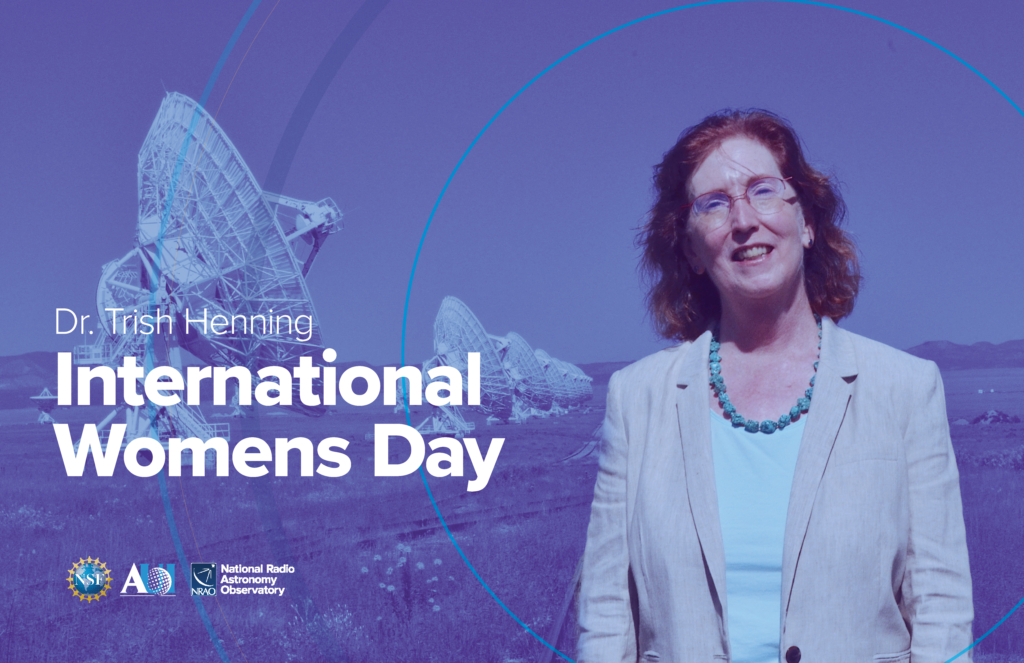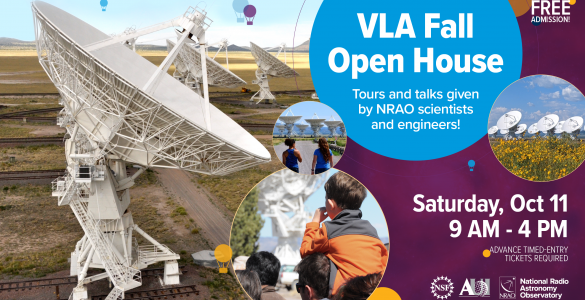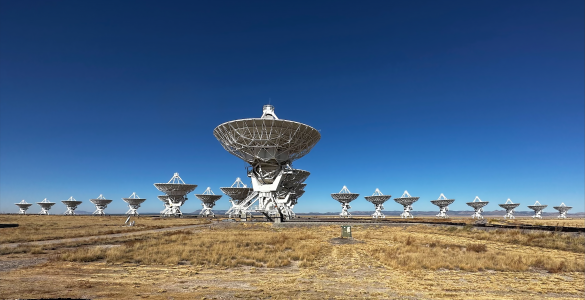This International Women’s Day, the National Radio Astronomy Observatory (NRAO) celebrates the selection of Dr. Patricia (Trish) Henning as the next Associate Director for New Mexico Operations. In this position, she will lead the operations of the National Science Foundation’s Karl G. Jansky Very Large Array (VLA), the continent-wide Very Long Baseline Array (VLBA), and the Domenici Science Operations Center in Socorro. She formerly served as NRAO’s Assistant Director for New Mexico Operations and Assistant Director for Science Support and Research.
Dr. Henning’s journey to the forefront of radio astronomy began with a passion for unraveling the mysteries of the Universe. After earning her Ph.D. in astronomy from the University of Maryland, she received a postdoctoral appointment at the Netherlands Institute for Radio Astronomy, where she honed her expertise in the field. In 1993, Dr. Henning joined the University of New Mexico (UNM), where she was a professor of physics and astronomy, and held various leadership roles while continuing her groundbreaking research with radio telescopes.
At UNM, Dr. Henning’s leadership extended far beyond her immediate research area. As Director of the Institute for Astrophysics and Associate Vice President for Research, she played a pivotal role in shaping the university’s research agenda and fostering interdisciplinary collaboration. Her tenure as Head of User Programs for the Long Wavelength Array and Associate Chair of the Department of Physics and Astronomy showcased her commitment to advancing scientific inquiry and nurturing the next generation of astronomers.
In her new role at NRAO, Dr. Henning is poised to lead New Mexico Operations with a vision for innovation and excellence. With oversight of prestigious facilities such as the VLA and the VLBA, she aims to keep NRAO at the forefront of astronomical research while fostering a culture of inclusivity and collaboration. Although this role is new to Dr. Henning, she is no stranger to positions of leadership. When asked what effective leadership looks like, Dr. Henning responded saying, “A great leader gives people what they need to do what they do best. The higher up you are in any organization, the more people you serve. Ultimately, our common goal is serving the community and exciting the public about science and helping people make discoveries.”
As a trailblazer in the field of radio astronomy, Dr. Henning is a staunch advocate for gender equality and diversity in STEM. Drawing from her own experiences, she underscores the importance of creating inclusive environments where all voices are heard and valued.
“Gender equality and opportunity in STEM in general means everyone is welcome, and everyone is welcome to bring their own perspective, but it goes beyond that,” Henning emphasized. “We need everyone’s perspective. Everyone’s lived experience will impact how they solve a problem and how they come up with a creative solution no one has thought of before. Equality leads to the best science because you’re not missing out on talent because folks aren’t allowed in the room.”
Dr. Henning was also asked what advice she would give to women considering pursuing a career in astronomy or science in general. “If you want to be in astronomy – astronomy is very exciting because I think it’s the broadest science there is. You need to know a lot about mathematics and computation, and also physics. Astronomy encompasses all subfields of physics. Gravity, radiation interacting with matter, etc… The point is that you have to know a lot about a lot of different kinds of physics which, to me, makes it fun.” “When you’re learning,” Dr. Henning continued, “you get to learn a lot of different things. You have to take the math and the physics and the astrophysics basics, but know that astronomy brings many concepts together, so be looking for the linkages. There are new discoveries all the time, so try to get in touch with brand-new discoveries and read about them. Follow up and ask questions about things that spark your interest. And when things spark your interest, get ready to dive in. Be ready to be amazed, and learn the background math and physics to be able to understand what cutting-edge astronomy really is.”
Although the world of STEM hasn’t always been particularly inclusive or accepting, Dr. Henning says that the world has changed. “When I was first starting out, well I went to a women’s college. Before that, I was a good student, and it wasn’t until I went to college that I really thought about doing science. If I hadn’t gone to a women’s college, I’m not sure that would have been true. I saw my astronomy professor, who was a woman, and I saw her teaching and thought, ‘Maybe I can do that.’” Dr. Henning continued, “I went to grad school and it was so different and male dominated. When I was a postdoc, one of the senior astronomers at the time said ‘You have to be twice as good because you’re a woman’. I hope that’s dead. My sense is it is. I would have given you a different answer 30 years ago. There was a time where we weren’t invited into the room…where we had to kind of break down the door.” Dr. Henning believes there’s more to diversity than simply equal opportunity. “The human part – the flipside,” she said, “is that I strongly believe that the universe belongs to everybody, and no one group has a lock on the universe. We all have the right to ask the profound questions. Because that’s what astronomy is. And so gender equality just recognizes that the sky is everyone’s. We need everybody to be out there studying, being creative, working hard, and making new discoveries.”
Dr. Patricia Henning’s appointment as Associate Director for New Mexico Operations marks a significant milestone in the annals of radio astronomy. With her visionary leadership, unwavering dedication, and commitment to excellence, she is poised to inspire future generations of scientists and shape the course of astronomical discovery for years to come.
About NRAO
The National Radio Astronomy Observatory (NRAO) is a facility of the U.S. National Science Foundation, operated under cooperative agreement by Associated Universities, Inc.
For media inquiries or further information, please contact:
NRAO Media Contact
Corrina C. Jaramillo Feldman
Public Information Officer – New Mexico
VLA, VLBA, ngVLA
Tel: +1 505-366-7267
cfeldman@nrao.edu















